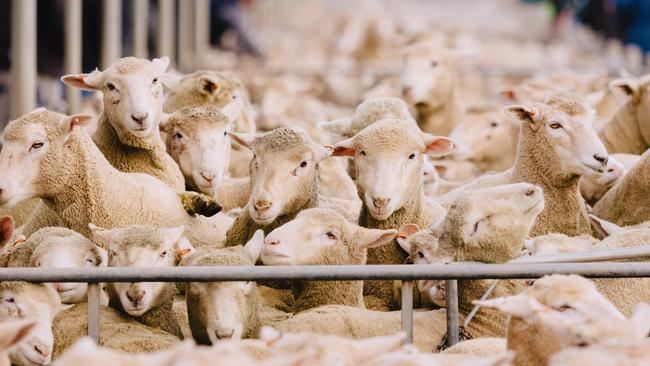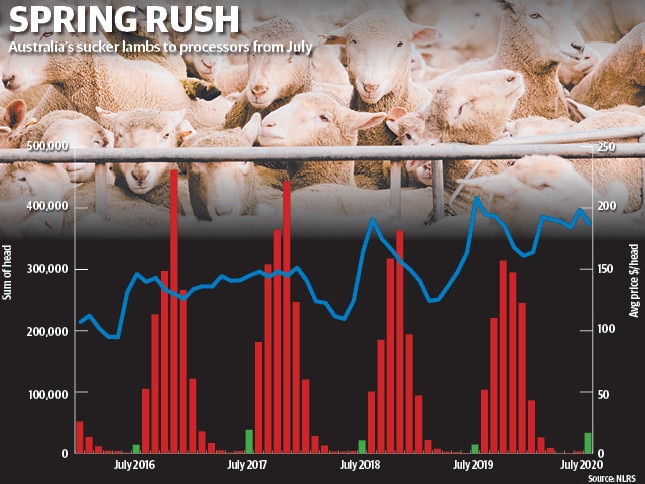Lamb not worth the weight
There’s plenty of uncertainty in the lamb market but with the compensation of extra weight and freshness, the dollar per head returns are still tracking OK.

THE lamb market is a basket-case of problems and uncertainty at present.
But taking an optimistic view, dollar per head returns for the sucker lambs starting to be sold are still sound.
Figures collected by the National Livestock Reporting Service have the average price for young lambs sold to processors so far this month at $186 across all major eastern states saleyards, which is in the $7-$8/kg range.
Yes, in cents by kilogram carcass terms the market is not where people had hoped it would be, with the anticipated $9 and $10/kg now committed to history, at least while COVID-19 rules the world.
But with the compensation of extra weight and freshness in early suckers this year thanks to the improved season, dollar per head returns are still tracking OK, at least in comparison with recent years.
The $186 result is the second best July for suckers in the past five years.
It is beaten only by last year’s average of $208, when the drought was still biting and lambs with weight were scarce.
Sucker lambs are now starting to move across the early production areas in NSW, with just dribbles appearing in Victoria and South Australia.
Some 1500 very good suckers sold at Deniliquin in southern NSW last week in a tight band of $168 to $180.
Southern Riverina Livestock auctioneer Steve Arentz said they had all been bred out of Merino ewes and for a young lamb straight off mum it was good money, particularly for the Riverina where station grazing conditions do not always favour the turn-off of prime suckers.
“We would be happy to sell suckers for that kind of money every day of the week,’’ he said.
Which leads on to the next key question plaguing farmers and agents alike: to meet the market and sell young lambs as they become ready or hold in the hope the big abattoirs closed due to coronavirus infections re-open and the market gains momentum in the weeks ahead.
It’s a question no one is willing to speculate about due to the unprecedented times the industry finds itself in.
As one auctioneer at Bendigo said this week when asked about what advice they were giving farmers in regards to marketing lambs: “We are all so firmly on the fence at the moment we have splinters up our arse. No one knows what to do.’’

So what is the data saying?
It may surprise, but the turn-off of suckers this July is actually much higher than 12 months ago and indeed in recent years.
NLRS reporters have collected data on more than 30,000 suckers sold so far this July, compared with 14,000 a year ago.
The graph on this page shows the build-up of suckers over a year, covering the seasons from 2016 until now.
It shows a rapid build-up from August onwards, with the spring months of October and November the peak supply periods.
Overlaid on this graph is the trend line of price in dollar per head terms, noting that the lamb market has been on a rising plane for a number of years due mainly to the influence of a shrinking Australian sheep flock.
Predicting price performance for suckers into the spring is impossible due to the rare circumstances affecting the lamb industry from coronavirus.
But a strong trend coming through from current sales is that weight is not being rewarded, and farmers need to consider the value of taking young lambs to higher weights.
These have been the somewhat unusual outcomes for sucker lambs at sales in the past week.
There was a price spread of just $12 across sucker lambs weighing from around 20kg to nearly 27kg cwt at Deniliquin last week.
The average reported by the NLRS for 20-22kg suckers was $173, compared with $177 for heavier types in the 24-26kg category.
The same average dollar return of $173 for domestic suckers 20-22kg and heavier runs 22-24kg was recorded at Forbes in NSW.
At Swan Hill, $170 was paid for the lead run of suckers estimated at 26-27kg, with the seconds at 24-25kg making more, at $178.
MORE


